Table of Contents
Natural Scent for Home: How to Make Your House Smell Good Without Toxic Chemicals
This page may contain affiliate links. We may earn a commission on purchases, at no additional cost to you. Learn more →
Natural scent for home? Of course, everyone wants their home to smell amazing. But if you’re relying on conventional air fresheners, you might be doing more harm than good. Synthetic fragrances can release a cocktail of toxic chemicals that linger in the air, cling to your furniture, and even impact your health. According to the Environmental Working Group (EWG), many air fresheners contain phthalates—endocrine disruptors linked to hormone interference, birth defects, and reproductive harm.
That’s the problem. And it gets worse when you realize how many of these products hide behind vague ingredient labels like "fragrance."
But here's the good news: you can absolutely make your home smell amazing using natural, non-toxic methods that are just as effective—and infinitely healthier.
This article is your step-by-step guide to creating a beautifully scented home without toxic chemicals. We’ll break down the hidden dangers of synthetic fragrances, explore safe alternatives that actually work, and show you how to keep your space smelling fresh every single day.
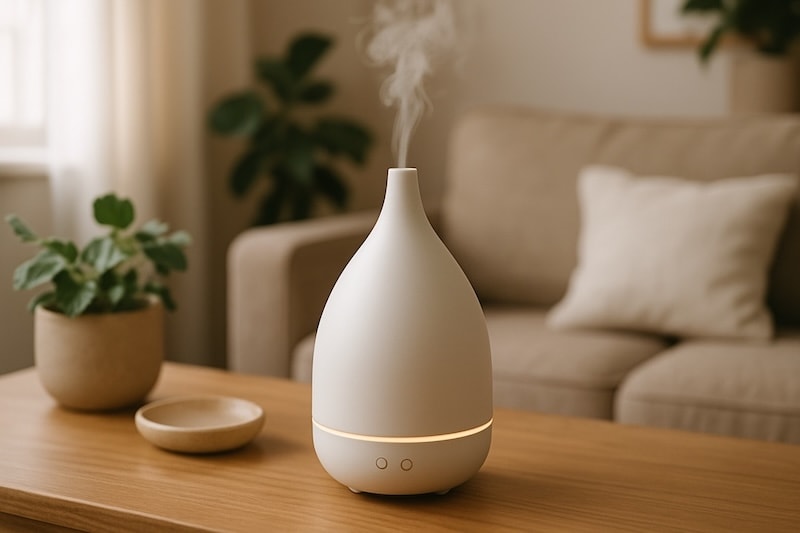
Key Takeaways
-
Synthetic air fresheners often contain undisclosed chemicals like phthalates, benzene, formaldehyde, VOCs, and other harmful chemicals linked to hormone disruption, cancer and asthma.
-
Eliminate Odors First: True freshness begins with removing odor sources. Regular cleaning, ventilation, and odor absorbers (activated charcoal, baking soda) neutralize smells at the source, preventing masking.
-
Non-toxic options like herbal natural room sprays, essential oils, simmer pots, reed diffuser blends and beeswax candles can replace synthetic options without health risks add mood-boosting aroma without residue.
-
Essential Oils – Use Wisely: While popular, essential oils are concentrated. Over-diffusing can create irritants (e.g., formaldehyde) and pose risks to pets or sensitive individuals. Use moderately and ensure proper ventilation.
-
Simple Natural Solutions: Cross-breeze ventilation, houseplants (like lavender or jasmine), and stovetop simmers offer effective, safe ways to maintain a pleasantly scented home.
-
Natural scents may not last as long as synthetics but are safer and easy to refresh.
Why Conventional Air Fresheners Can Be Harmful
Let’s start with the problem: Most conventional air-freshening products—candles, sprays, plug-ins—are made with synthetic chemicals, often hidden under a single “fragrance” label. That word alone can legally hide nearly 4,000 different chemicals, many of which have never been independently tested for safety (IFRA).
Fragrance can include phthalates, endocrine disruptors linked to reproductive issues, found in 86% of tested air fresheners by the Natural Resources Defense Council. Other harmful compounds like benzene, toluene, and formaldehyde are emitted from scented paraffin candles. The U.S. EPA classifies these as carcinogenic VOCs that irritate lungs and trigger asthma.
Lack of transparency means you might unknowingly breathe a “toxic cocktail”. These products can react with indoor air to form new pollutants like formaldehyde, which bind to dust, settle on surfaces, and recirculate, leading to prolonged exposure. You inhale them, your kids roll around in them, and pets lick them off the floor. As chemist Ryan Sullivan notes, “Products can contain dozens of chemicals, and all it shows up as is one word on the ingredient list: fragrance”.
In short, you might be not just spraying lavender—you might be spraying phthalates, VOCs, and petroleum byproducts.
Conventional air fresheners mask odors at the potential cost of your indoor air quality and health. Natural alternatives are a safer choice.
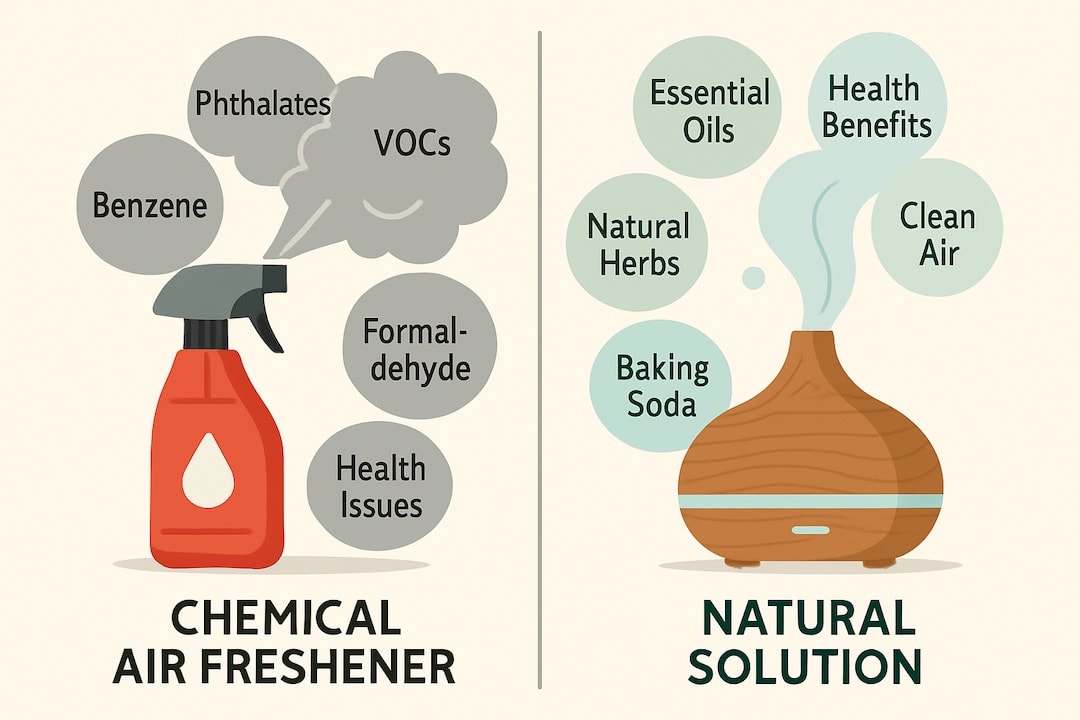
Step 1: Eliminate Odors at the Source
You can’t just cover up bad smells. That’s what synthetic products try to do. The first rule of a naturally fresh home is this: remove what’s causing the odor. This involves basic hygiene and ventilation:
Regular Cleaning
Empty trash frequently, clean refrigerators, wash pet bedding, and dust/vacuum regularly. Dust traps smelly particles and fragrance chemicals. Deep clean carpets and upholstery periodically to prevent odor buildup.
Common Sources of Indoor Odors
-
Trash bins (especially compost or food waste)
-
Pet beds, litter boxes, and carpeted areas
-
Kitchen drains and under-sink moisture
-
Moldy laundry or musty closets
-
Forgotten leftovers in the fridge
Simple, Natural Odor Removers
-
Baking Soda: Absorbs acidic and basic odors. Use it in open jars, or sprinkle on carpets before vacuuming
-
White Vinegar: Neutralizes odors on contact. Leave a bowl out overnight or add to laundry and cleaning water.
-
Activated Charcoal: Odorless and extremely effective at absorbing smells and moisture. Ideal for closets and basements.
-
Ventilation: Open your windows for 10–15 minutes daily. Even a short burst of fresh air reduces indoor air pollution significantly (EPA).
By eliminating odor sources, you create a clean slate, ensuring natural scents truly enhance your home, rather than just masking bad smells.
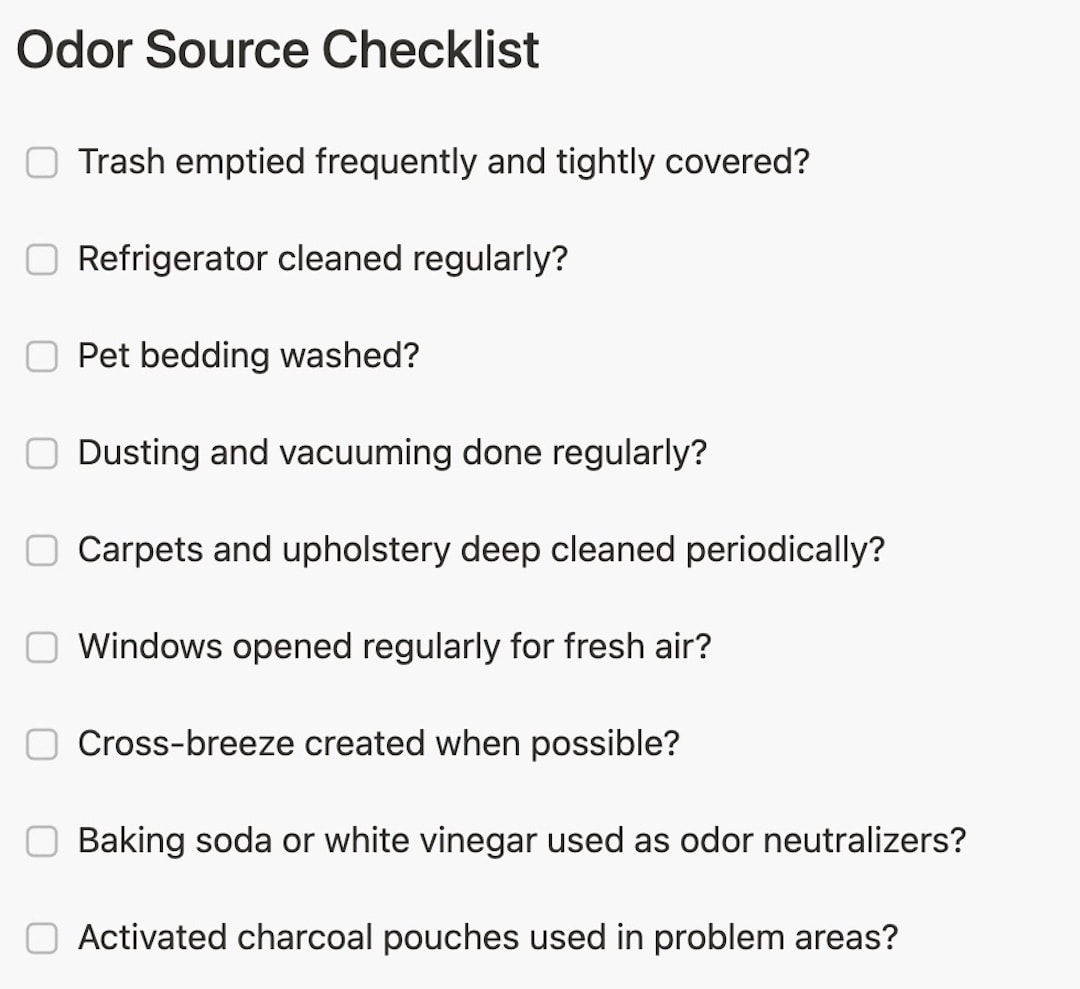
Step 2: Add Natural Scents to Your Home
Once you’ve cleared out the funk, you’re ready to add pleasant natural scents that bring joy, calm, or focus into your space. Here are some proven, non-toxic options:
Diffuse Essential Oils for a Safe Aroma
Essential oil diffusers are popular for spreading natural fragrance. They use water and a few drops of pure essential oil to mist scent into the air, avoiding artificial chemicals. For example, 3–5 drops of lavender oil can scent a medium room. Citrus oils (lemon, sweet orange) are great for kitchens, providing uplifting freshness and neutralizing cooking odors. Make sure the oils are organic and 100% pure and not mixed with synthetic carriers.
Caution: Some essential oils (e.g., tea tree, citrus, eucalyptus) can be harmful to pets. Use pet-safe oils only and ensure good ventilation
Make DIY Natural Room Sprays
Mix 1 cup distilled water, 1 cup vodka (or witch hazel), and 15–20 drops of essential oil in a glass spray bottle. Shake well before each use. Spray into air or use on fabrics as a linen spray (test a small area first).
For quick freshness, mix 1 cup distilled water with 1 cup rubbing alcohol (or witch hazel) and ~15 drops of essential oil in a spray bottle. Lavender is excellent for calming bedrooms or linens. Customize with other oils (e.g., peppermint + orange for holidays) - make it your new favorite non toxic air freshener! Spray into air or on fabrics (test a small area first) and store in a glass bottle away from sunlight and label clearly.
Create Herbal Sachets
Place dried lavender, rose petals, cedar chips, or mint leaves in small cotton bags. Tuck them into drawers, closets, or under pillows. Refresh monthly with a few drops of matching essential oil. These release gentle, consistent fragrance without chemicals and scents home naturally.
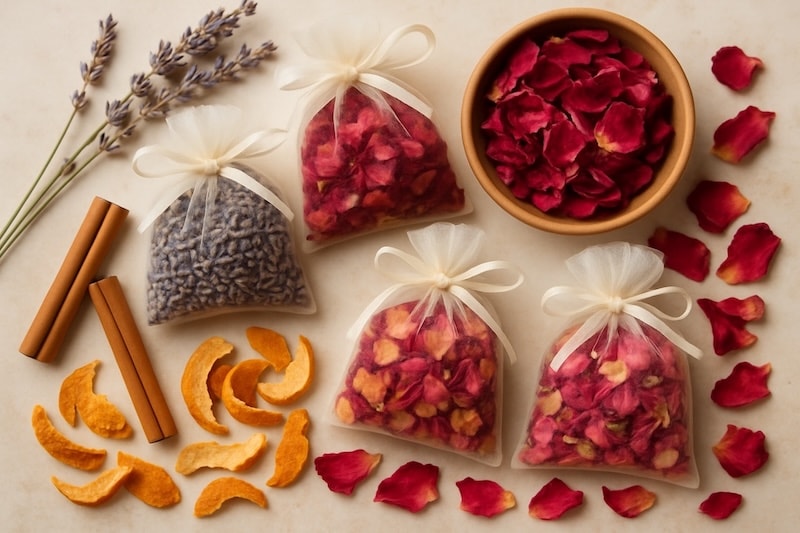
Simmer a Stovetop Potpourri
Fill your home with natural fragrance by simmering water with aromatic ingredients like orange/lemon slices, cinnamon sticks, cloves, and vanilla extract . This creates a subtle, continuous scent. Experiment with (fresh) rosemary and lemon, or apple and ginger.
Pro Tip: Keep water topped up. Reuse ingredients for 1-2 days by refrigerating. A slow cooker on low can provide all-day scenting.
Utilize Fresh Indoor Plants
Many indoor plants purify air and emit subtle fragrances. Jasmine, gardenia, and lavender are fragrant choices. Even non-flowering plants like spider plants remove toxins.
Use Coffee Grounds as Odor Absorbers and Scent Enhancers
Coffee grounds absorb odors and impart a pleasant aroma. Their porous nature neutralizes smells in kitchens or refrigerators. They trap and eliminate odors, leaving a faint coffee scent. Just place open bowls of fresh or dried used grounds in problem areas.
Consider Natural Reed Diffusers
Natural reed diffusers offer continuous, flameless scent. They use a base oil (non-toxic solvent, essential oils) and porous reeds. Reeds soak up oil and gradually release aroma without heat or electricity.
Passive Jar Deodorisers
-
Half-fill a mason jar with baking soda.
-
Add 10 drops lemon oil and 5 drops orange.
-
Cover with breathable fabric and secure with a ring.
The soda traps odours; oils lend natural scents that last several hours before needing a top-up.
Light Natural Candles like Beeswax or Soy Candles
Look for candles made with 100% beeswax or soy, scented with essential oils (not "fragrance oil"). Bonus: Beeswax candles have a gentle honey-like scent, and burn cleanly and is a natural product.
Pro Tip: Trim wicks to 1/4 inch before each use for clean, even burn.
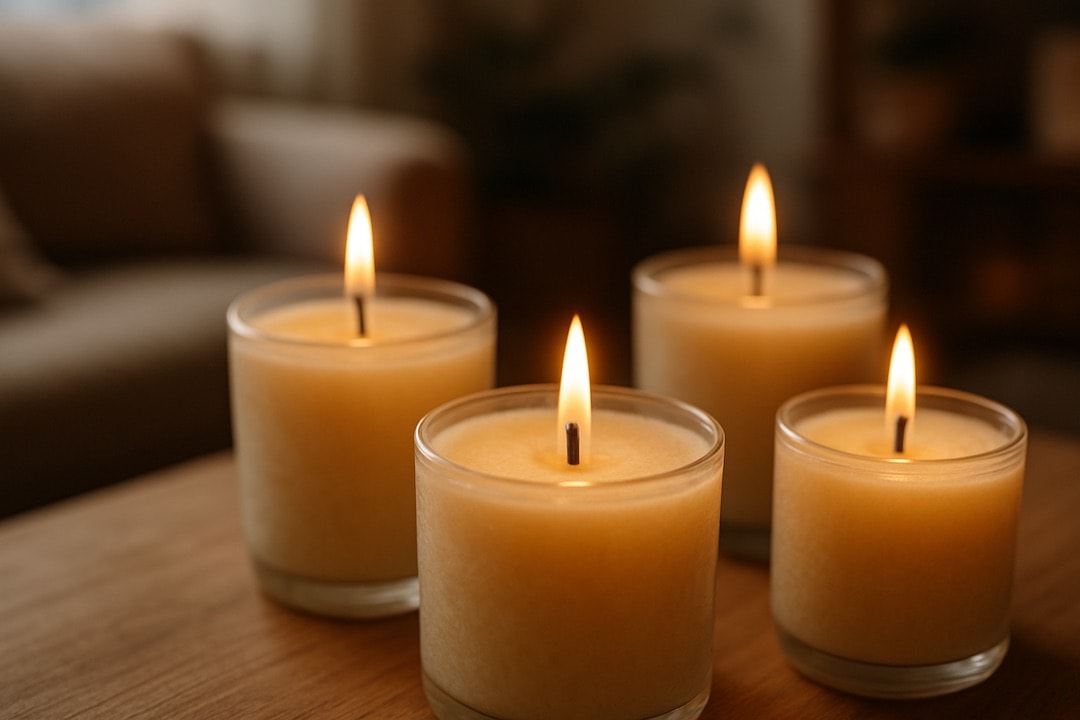
Step 3: Maintain Long-Term Freshness
Creating a naturally scented home isn’t a one-time fix—it’s a lifestyle. Here’s how to keep it fresh every day:
-
Open windows daily, even just for 5–10 minutes.
-
Vacuum weekly, especially if you have pets.
-
Place baking soda jars in closets, under sinks, and near litter boxes.
-
Rotate scents seasonally: citrus and mint for summer, cinnamon and clove for fall, pine and vanilla in winter.
-
Clean kitchen drains monthly with baking soda + vinegar.
Natural vs. Synthetic: Which Works Better?
You might be wondering: Do natural scents actually work as well as synthetic ones?
In short, yes—with one consideration. Natural scents don’t "last" as long because they don’t contain chemical fixatives like phthalates. But you can refresh them safely and easily.
Plus, they offer added wellness benefits. For example, a study published in Frontiers in Psychology found that inhaling lavender essential oil reduced anxiety and improved mood in clinical trials.
Synthetic fragrances, meanwhile, are linked to a host of health issues, from asthma triggers to hormone disruption. So the real question isn’t "Which works better?" but rather "Which makes you feel better?"

Conclusion: A Home That Smells Like You, Naturally
Fresh air. Real plants. Pure essential oils. There’s nothing more welcoming than a home that smells like life itself—not like a synthetic "spring breeze" or "sugar cookie" knockoff.
Creating a naturally fresh home isn’t about covering smells—it’s about embracing real, healthy scents that reflect your values and make you feel good. It’s also an act of care: for your family, your pets, and yourself.
Start small. Choose one method from this article to try today. Maybe it’s simmering lemon and rosemary on the stove, or swapping out your old candle for a beeswax one.
FAQ
What is the best natural scent for home?
Lavender, citrus (like lemon and orange), rosemary and eucalyptus are among the most popular natural scents. They’re fresh, calming, and widely used in aromatherapy.
How do you make your house smell nice naturally?
Use essential oil diffusers, simmer pots, baking soda, and open windows. Simmering citrus and herbs or spraying a homemade EO mix works instantly without toxins.
How do you make natural scents for your house?
Natural scents can be created using simple DIY recipes with three basic ingredients: water, essential oils, and a carrier like vodka or witch hazel. The most effective ratio is 3/4 cup water, 2-3 tablespoons alcohol, and 10-20 drops essential oils. You can also make simmer pot blends with lemon, cinnamon, and rosemary for spa-like aromas
What three ingredients make your house smell good naturally?
The most effective three ingredients are: lemon, cinnamon, and rosemary. This combination provides citrus freshness, warm coziness, and herbal therapeutic benefits. Alternative combinations include baking soda with essential oils and water for spray solutions, or fabric softener with baking soda for longer-lasting scent
Are essential oils safer than synthetic fragrances?
In general, yes—when used properly. But some oils may irritate sensitive individuals or be toxic to pets. Use sparingly and research each oil before use.
Which natural ingredients absorb odors?
Baking soda, activated charcoal, vinegar, and coffee grounds are effective, natural odor absorbers.













